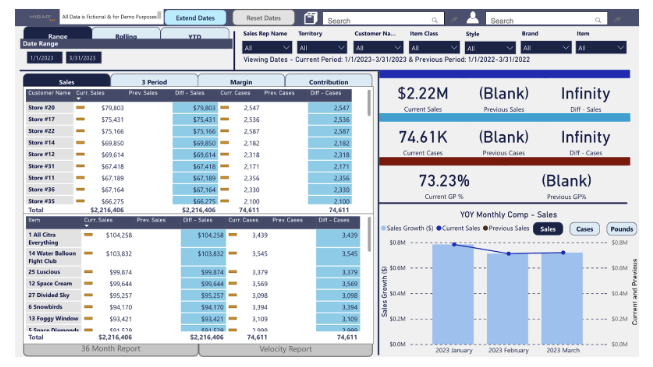The role of a controller has traditionally been rooted in overseeing an organization’s financial and accounting operations, but as businesses evolve in the digital age, you are increasingly called upon to harness the power of data analytics, particularly sales data, to drive financial success. The convergence of accounting and data analytics allows you to translate intricate sales data into actionable insights, amplifying your company’s financial health.
To that end, join us as we explore the pivotal role controllers play in sales data analysis and how you can achieve greater synergy between your accounting and sales teams.
The Role of Controllers in Sales Data Analysis
At its core, sales data offers a raw, quantitative snapshot of your company’s operations. It provides metrics like the number of units sold, revenue generated, customer demographics, and sales trends, but in its raw form, it’s just a sea of numbers.
Here is where you can step in and leverage your financial acumen to do the following:
1. Interpret Data Contextuality
You can use your comprehensive understanding of the company’s financial landscape to contextualize its sales data. While other departments may only understand the “what,” you can look past the surface and determine the “why” behind the numbers.
2. Forecast Financial Trends
By analyzing current and historical sales data, you can anticipate future financial trends. Looking ahead enables proactive decision-making, allowing you to mitigate risks and seize fleeting opportunities.
3. Identify Revenue Opportunities
Through meticulous analysis, you can identify partners, such as the products that have the highest margins or the sales channels that are most impactful. You can then apply these insights to future campaigns and capitalize on avenues for increased revenue.
Best Practices in Sales Data Analysis
If you want to make the most of your sales data, you should follow these best practices:
Adopt Robust Analytical Tools
Modern software platforms, like Tableau or Power BI, offer robust analytics capabilities that can help in visualizing data, tracking key performance indicators, and generating detailed reports.
To maximize the return on these tech investments, consider pairing core platforms with complementary software add-ons.
For instance, the MIBAR Power BI Sales PowerPack visualization tool expands on the native analytics capabilities of the Power BI platform to:
- Access your sales data in real-time, allowing you to make faster, more informed decisions based on the latest information.
- Slice and dice your data on multiple dimensions to evaluate your sales and margin activity without having to run lengthy reports.
- Leverage pre-built content packs specifically designed for Power BI or your ERP, making it easy to get started with data analytics right away.
- Seamlessly share the content with you team, customers and vendors as this visualization can be used by sales, marketing, purchasing and finance teams to stay ahead of the emerging trends of your business.
- Establish user security roles to limit visualization of cost/profit data.

Continuously Monitor Sales Data
Instead of periodically checking in with your team every quarter, you should embrace the concept of continuous monitoring, a real-time approach that ensures timely insights and rapid responses to any anomalies or opportunities.
Collaborate With IT
Collaborate with your IT department to maintain data integrity and cybersecurity. Your IT personnel can implement integrations, help you identify new software tools, and bring your analytics strategy to life.
Stay Apprised of Market Trends
External factors, such as market trends and economic conditions, can influence sales, so you must stay apprised of these dynamics to ensure that your analysis accounts for this broad set of variables.
Bridging the Gap: Collaboration Between Accounting and Sales Teams
The effective analysis of sales data is not an isolated endeavor. It necessitates a symbiotic relationship between your accounting and sales teams.
With that being said, here’s how you can nurture collaborative synergy:
Regular Interactions
Foster an environment in which your accounting and sales teams interact regularly. These meetings don’t have to be formal or rigid: Simply having a weekly get-together for coffee can build chemistry and help these two teams learn to work together.
Education
Educate your sales team about the financial implications of sales data. Conversely, you can connect with your sales teams to provide your accounting department with on-ground insights that may not be immediately evident from raw data.
Joint Strategy Sessions
As you formulate financial strategies or sales campaigns, make sure to involve both teams. These collaborative strategy sessions will yield holistic plans that consider your overarching financial goals and the immediate needs of the sales team.
Feedback Channels
Create feedback channels through which sales and marketing team members can share information and communicate with one another. The sales teams should be apprised of financial analysis results, and they, in turn, can offer feedback based on their real-world experiences.
Also, make sure to encourage everyone to voice their concerns. If the sales team is not on board with something you’re doing, you need to know about it, as they may be able to provide a unique perspective and identify potential issues that you might have overlooked.
The Journey From Data to Dollars Is a Collaborative One
The role of a controller has moved beyond traditional accounting functions. As a top financial professional within your organization, you are entrusted with the critical task of turning data into dollars by harnessing information from across all departments and teams.
However, that journey must be a collaborative effort. Through mutual understanding, shared objectives, and consistent collaboration, your sales and finance teams can jointly steer the organization toward a brighter future, and by arming yourself with analytical prowess and collaborative spirit, you can serve as a valuable catalyst for financial growth.
Additional Resources
Controller/CFO KPIs: Days Sales Outstanding (DSO)




